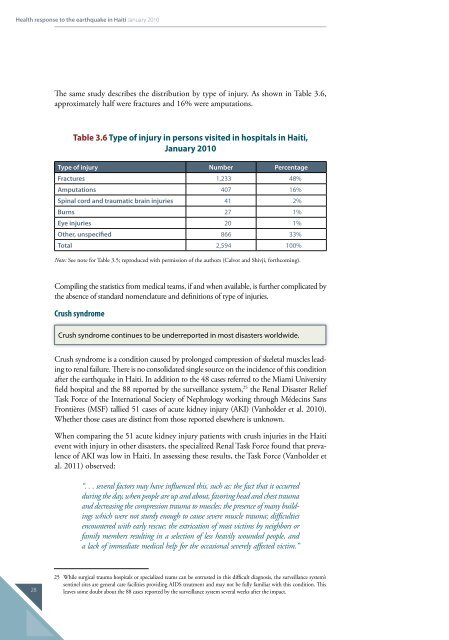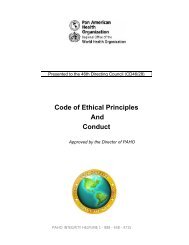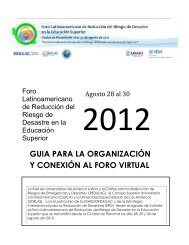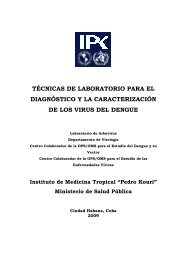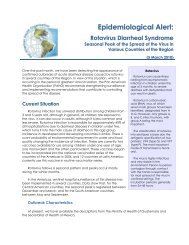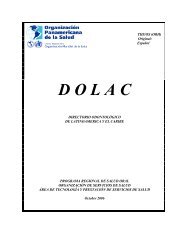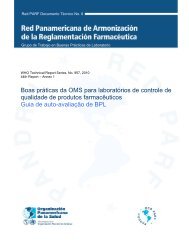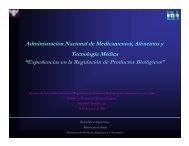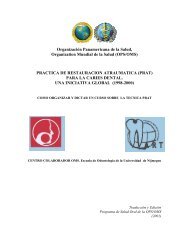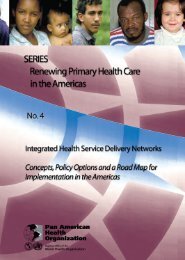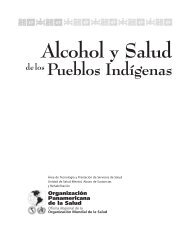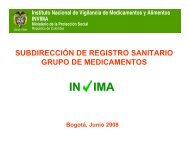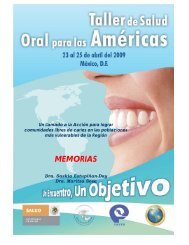Health response to the earthquake in Haiti, January 2010
Health response to the earthquake in Haiti, January 2010
Health response to the earthquake in Haiti, January 2010
- No tags were found...
Create successful ePaper yourself
Turn your PDF publications into a flip-book with our unique Google optimized e-Paper software.
<strong>Health</strong> <strong>response</strong> <strong>to</strong> <strong>the</strong> <strong>earthquake</strong> <strong>in</strong> <strong>Haiti</strong> <strong>January</strong> <strong>2010</strong>The same study describes <strong>the</strong> distribution by type of <strong>in</strong>jury. As shown <strong>in</strong> Table 3.6,approximately half were fractures and 16% were amputations.Table 3.6 Type of <strong>in</strong>jury <strong>in</strong> persons visited <strong>in</strong> hospitals <strong>in</strong> <strong>Haiti</strong>,<strong>January</strong> <strong>2010</strong>Type of <strong>in</strong>jury Number PercentageFractures 1,233 48%Amputations 407 16%Sp<strong>in</strong>al cord and traumatic bra<strong>in</strong> <strong>in</strong>juries 41 2%Burns 27 1%Eye <strong>in</strong>juries 20 1%O<strong>the</strong>r, unspecified 866 33%Total 2,594 100%Note: See note for Table 3.5; reproduced with permission of <strong>the</strong> authors (Calvot and Shivji, forthcom<strong>in</strong>g).Compil<strong>in</strong>g <strong>the</strong> statistics from medical teams, if and when available, is fur<strong>the</strong>r complicated by<strong>the</strong> absence of standard nomenclature and def<strong>in</strong>itions of type of <strong>in</strong>juries.Crush syndromeCrush syndrome cont<strong>in</strong>ues <strong>to</strong> be underreported <strong>in</strong> most disasters worldwide.Crush syndrome is a condition caused by prolonged compression of skeletal muscles lead<strong>in</strong>g<strong>to</strong> renal failure. There is no consolidated s<strong>in</strong>gle source on <strong>the</strong> <strong>in</strong>cidence of this conditionafter <strong>the</strong> <strong>earthquake</strong> <strong>in</strong> <strong>Haiti</strong>. In addition <strong>to</strong> <strong>the</strong> 48 cases referred <strong>to</strong> <strong>the</strong> Miami Universityfield hospital and <strong>the</strong> 88 reported by <strong>the</strong> surveillance system, 25 <strong>the</strong> Renal Disaster ReliefTask Force of <strong>the</strong> International Society of Nephrology work<strong>in</strong>g through Médec<strong>in</strong>s SansFrontières (MSF) tallied 51 cases of acute kidney <strong>in</strong>jury (AKI) (Vanholder et al. <strong>2010</strong>).Whe<strong>the</strong>r those cases are dist<strong>in</strong>ct from those reported elsewhere is unknown.When compar<strong>in</strong>g <strong>the</strong> 51 acute kidney <strong>in</strong>jury patients with crush <strong>in</strong>juries <strong>in</strong> <strong>the</strong> <strong>Haiti</strong>event with <strong>in</strong>jury <strong>in</strong> o<strong>the</strong>r disasters, <strong>the</strong> specialized Renal Task Force found that prevalenceof AKI was low <strong>in</strong> <strong>Haiti</strong>. In assess<strong>in</strong>g <strong>the</strong>se results, <strong>the</strong> Task Force (Vanholder etal. 2011) observed:“. . . several fac<strong>to</strong>rs may have <strong>in</strong>fluenced this, such as: <strong>the</strong> fact that it occurreddur<strong>in</strong>g <strong>the</strong> day, when people are up and about, favor<strong>in</strong>g head and chest traumaand decreas<strong>in</strong>g <strong>the</strong> compression trauma <strong>to</strong> muscles; <strong>the</strong> presence of many build<strong>in</strong>gswhich were not sturdy enough <strong>to</strong> cause severe muscle trauma; difficultiesencountered with early rescue; <strong>the</strong> extrication of most victims by neighbors orfamily members result<strong>in</strong>g <strong>in</strong> a selection of less heavily wounded people, anda lack of immediate medical help for <strong>the</strong> occasional severely affected victim.”2825 While surgical trauma hospitals or specialized teams can be entrusted <strong>in</strong> this difficult diagnosis, <strong>the</strong> surveillance system’ssent<strong>in</strong>el sites are general care facilities provid<strong>in</strong>g AIDS treatment and may not be fully familiar with this condition. Thisleaves some doubt about <strong>the</strong> 88 cases reported by <strong>the</strong> surveillance system several weeks after <strong>the</strong> impact.


